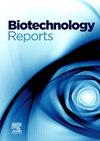中国仓鼠卵巢细胞瞬时生成RBD-Fc融合蛋白的设计质量
Q1 Immunology and Microbiology
引用次数: 0
摘要
设计质量(QbD)应用于上游工艺,以最大限度地提高CHO细胞中RBD-Fc融合蛋白的产量。基于风险分析(FMEA)确定培养时间、温度和聚乙烯亚胺与质粒DNA (PEI-Max/pDNA)比值为关键工艺属性,并通过响应面优化以实现蛋白产量最大化。采用Box-Behnken设计,确定了RBD-Fc生产的最佳条件为培养时间5天,培养温度34.4℃,PEI-Max/pDNA比为4.2:1 (w/w),预测值为48 mg/L(理想率为92.8%)。PEI-Max/pDNA比值及其与培养时间的交互作用可达到最高产量(47.78±2.30 mg/l)。此外,纯化后的cho产生的RBD-Fc融合蛋白纯度高,并与其受体ACE2紧密结合。我们的发现表明,QBD工具可以识别关键参数,以促进扩大生产。本文章由计算机程序翻译,如有差异,请以英文原文为准。

Quality by design for transient RBD-Fc fusion protein production in Chinese hamster ovary cells
Quality by design (QbD) is applied to the upstream process to maximize the RBD-Fc fusion protein production in CHO cells. The three factors (culture duration, temperature, and polyethyleneimine to plasmid DNA (PEI-Max/pDNA) ratio) were identified as critical process attributes based on risk analysis (FMEA) and further optimized by response surface to maximize the protein yields. Using a Box-Behnken design, the optimal conditions for RBD-Fc production were determined to be a culture duration of 5 days, a culture temperature of 34.4 °C, and a PEI-Max/pDNA ratio of 4.2:1 (w/w) with a predictive value of 48 mg/L (desirability of 92.8 %). The PEI-Max/pDNA ratio and its interaction with culture duration to express the highest yield (47.78 ± 2.30 mg/l). In addition, the purified CHO-produced RBD-Fc fusion protein was highly pure and strongly bound to its receptor, ACE2. Our finding demonstrated that the QBD tools can identify the critical parameters to facilitate scaling-up production.
求助全文
通过发布文献求助,成功后即可免费获取论文全文。
去求助
来源期刊

Biotechnology Reports
Immunology and Microbiology-Applied Microbiology and Biotechnology
CiteScore
15.80
自引率
0.00%
发文量
79
审稿时长
55 days
期刊介绍:
Biotechnology Reports covers all aspects of Biotechnology particularly those reports that are useful and informative and that will be of value to other researchers in related fields. Biotechnology Reports loves ground breaking science, but will also accept good science that can be of use to the biotechnology community. The journal maintains a high quality peer review where submissions are considered on the basis of scientific validity and technical quality. Acceptable paper types are research articles (short or full communications), methods, mini-reviews, and commentaries in the following areas: Healthcare and pharmaceutical biotechnology Agricultural and food biotechnology Environmental biotechnology Molecular biology, cell and tissue engineering and synthetic biology Industrial biotechnology, biofuels and bioenergy Nanobiotechnology Bioinformatics & systems biology New processes and products in biotechnology, bioprocess engineering.
 求助内容:
求助内容: 应助结果提醒方式:
应助结果提醒方式:


